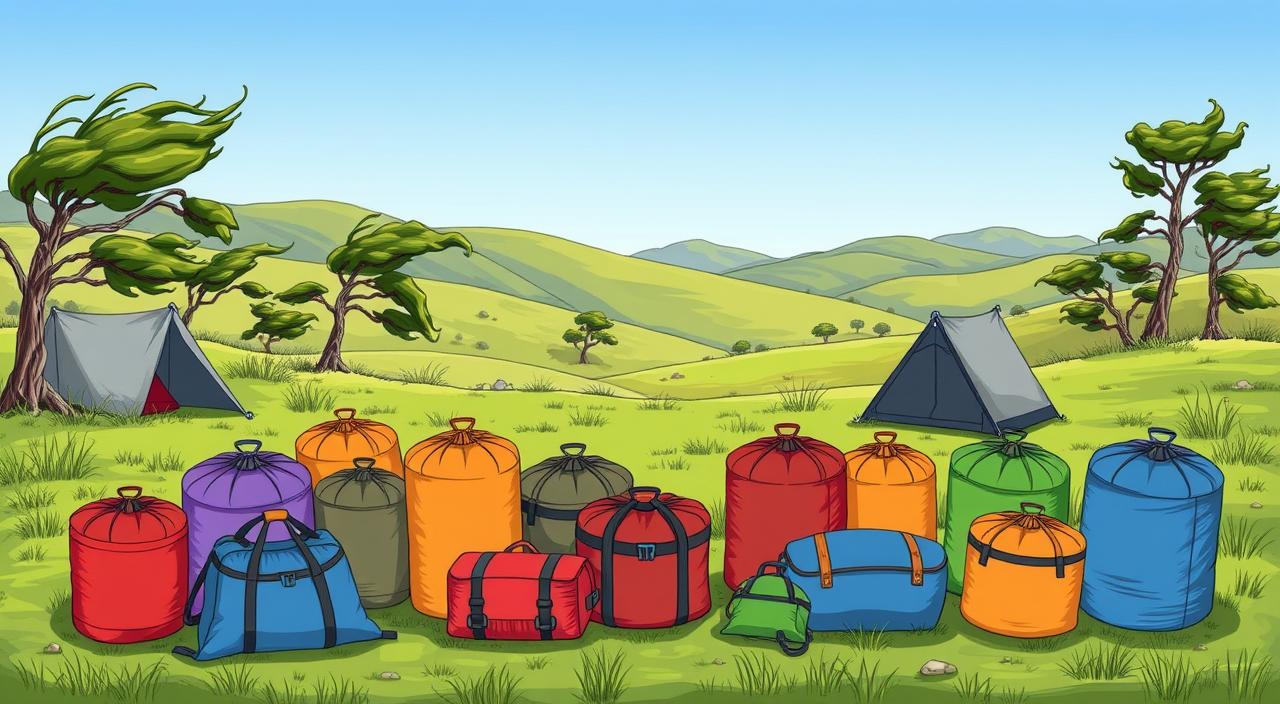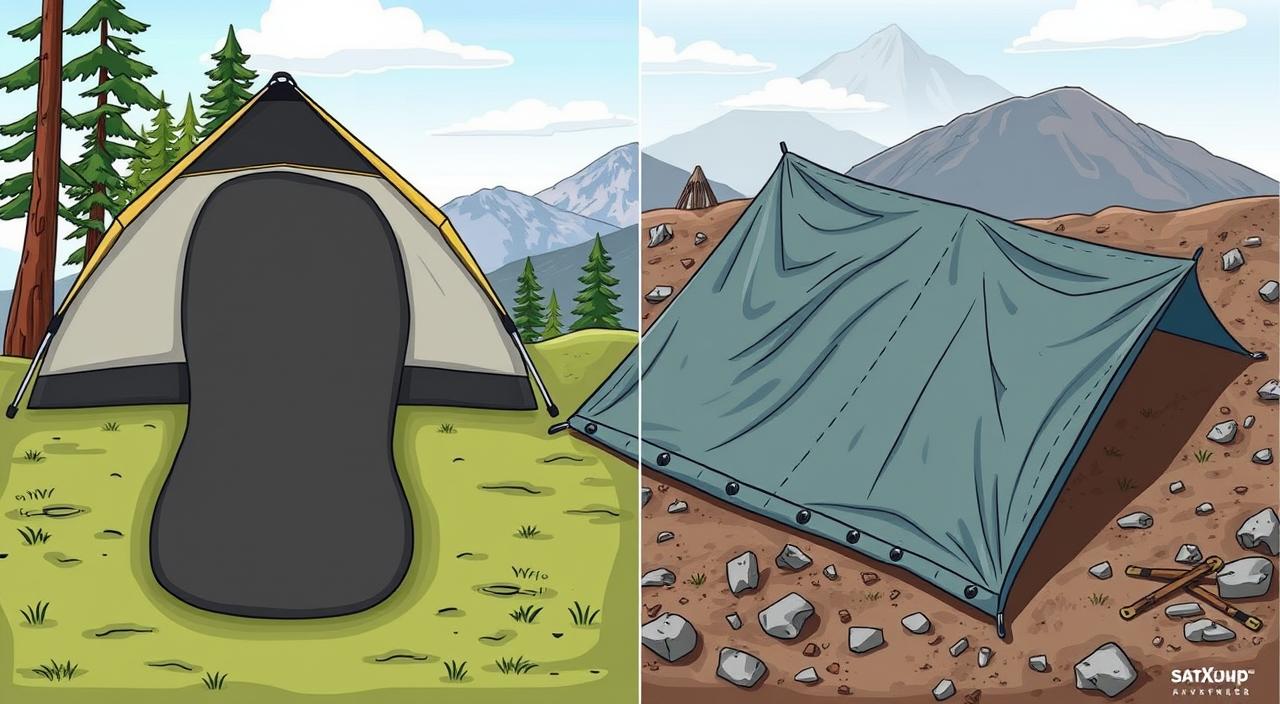
Disclaimer: This post may contain affiliate links. As an Amazon Associate, we earn from qualifying purchases.
Have you ever had trouble with a tent that wouldn’t stay still in the wind? You’re not the only one! Many campers deal with tents that don’t stay put, especially when the wind picks up. But, there’s good news: weight bags for tents can make this problem go away.
These bags are key for keeping your tent stable. They let you enjoy your outdoor trips without worrying about your tent flying away. Whether you’re camping in windy plains or breezy hills, these bags are a game-changer.
Key Takeaways
- Weight bags for tents improve stability in windy conditions.
- These tent weight bags are a must-have for outdoor enthusiasts.
- Proper use can enhance your camping experience significantly.
- Different types of camping weight bags are available for various needs.
- Understanding tent aerodynamics can make a huge difference in windy areas.
The Importance of Stability for Your Tent
Stability is key for a good camping trip, especially when it’s windy. A sturdy tent keeps you safe and comfy. But strong winds can test even the best tents, leading to accidents or damage if they’re not up to the task.
When it’s windy, keeping your tent stable is a must. For example, a 10×10 canopy tent needs 75-100 lbs per leg to stand strong. On hard ground like asphalt, you might need twice as much weight per leg in windy weather. This helps keep your tent safe and your gear in one piece.
Using the right weights is crucial. Windy beaches are the toughest, needing 100-125 lbs per leg because of the moving sand. Knowing this can make a big difference in your safety and fun.
Your tent’s stability affects how comfortable you’ll be. A well-secured tent keeps you safe from bad weather, lets you sleep well, and makes camping more enjoyable. Keep these tips in mind for your next trip.
What Are Weight Bags for Tents?
Weight bags for tents are key to a great camping trip, especially when it’s windy. They add extra weight to your tent’s base, making it more stable. This keeps your tent down and prevents it from moving in the wind.
Definition and Purpose
Weight bags for tents are made to add support against bad weather. They’re easy to adjust, making them good for both new and experienced campers. Using these bags helps keep your tent stable, so the weather won’t ruin your trip.
Types of Weight Bags Available
There are many types of weight bags for camping. Here are some:
- Tent sand bags: These are filled with sand or gravel for effective weight.
- Tent anchor bags: Perfect for securing tents on different grounds.
- Tent ballast bags: These add extra weight for stability in windy conditions.
- Weighted bags for tents: Made from strong materials to handle strong winds.
- Tent accessory bags: These bags are great for storing things and adding weight.
For instance, Stomp offers canopy weight bags made from tough nylon. They come in sets of four for $68.00 and take about 12 days to make. These bags are perfect for custom canopy tents and outdoor use.
| Type of Weight Bags | Material | Price | Set Size |
|---|---|---|---|
| Canopy Weight Bags | Nylon | $68.00 | 4 |
| Tent Sand Bags | Durable Fabric | Varies | Set of 4 |
| Tent Anchor Bags | Heavy-Duty Material | Varies | Set of 4 |
| Weighted Bags for Tents | Heavy-Duty Vinyl | Varies | Set of 4 |
Why You Need Weight Bags in Windy Conditions
Learning about tent aerodynamics is key to a great camping trip, especially when it’s windy. Wind can put a lot of pressure on a tent, making it unstable and increasing the chance of accidents. By using weight bags and placing your tent smartly, you can make your camp safer.
Understanding Tent Aerodynamics
Knowing how tent aerodynamics works helps you set up your tent right to fight the wind. Wind doesn’t just push on the tent; it interacts with it, causing different forces. In windy places, these forces can make your tent unstable, possibly causing it to collapse or fly away. Using weight bags can help balance these forces out. For instance, a 10×10 tent needs 75-125 lbs per leg in the wind, while a 10×20 tent requires 150-250 lbs per leg. Knowing this is crucial for staying safe while camping and helps manage wind pressure.
Real-Life Experiences with Windy Campsites
Outdoor lovers often talk about how important weight bags are for keeping tents stable in strong winds. Many share stories of underestimating the wind and ending up with tents that couldn’t handle it. Companies like REI and Western Mountaineering share stories that show how crucial having enough weights for the tent legs is. These stories prove that weight bags make tents more stable, giving you peace of mind in bad weather.
Choosing the Right Weight Bags for Your Tent
Choosing the right weight bags is key to keeping your tent stable in different weather. Think about your tent’s size, the wind you expect, and the gear you’re bringing. This will make your camping trip safer and more enjoyable.
Factors to Consider
Here are important things to consider when picking weight bags:
- Tent Size: Make sure the weight bags fit your tent. A small 10×10 tent needs at least one 40-pound weight at each leg.
- Wind Conditions: Think about the wind at your campsite. Big tents might need big cement block weights to stay put.
- Filling Materials: You can use sandbags, concrete blocks, or water weights. Sandbags are cheap and reliable.
- Packability: Consider how easy the weight bags are to carry. PVC pipes filled with concrete or 5-gallon sand buckets are good choices.
Recommended Materials for Durability
Weight bags need to last in tough camping conditions. Here are some top picks:
- Heavy-Duty Fabric: Choose materials like 18 oz PVC for their waterproof and UV protection.
- Reinforced Stitching: This keeps your weight bags strong under pressure. Double-stitched seams help them last longer.
- Easy Maintenance: Pick bags that are easy to clean and empty. This helps them last longer.

Choosing strong weight bags keeps your tent safe and improves your camping. Whether you choose sandbags, concrete blocks, or water weights, the right choice prevents injuries and keeps your tent stable. This makes your outdoor adventure better.
How to Use Weight Bags Effectively
Knowing where to put weight bags is key for a stable tent. By placing them right, your tent stays secure and stable in the wind. This way, your tent won’t shift or lift off the ground during your trip.
Placement Strategies
To get the best results, put a 40-pound weight at each tent leg. Here’s how:
- Put weight bags at the corners and along the sides for the best effect.
- Use sandbags or concrete-filled buckets for extra weight, especially when it’s windy.
- Make sure DIY weights, like PVC pipes filled with concrete, are securely fastened.
- Follow event rules that say you need at least 40 lbs per leg at places like farmers’ markets.
Combining Weight Bags with Other Stabilizers
Adding other stabilizers to your tent can make it even more stable. Here are some combining camping accessories ideas:
- Use guy lines or standard tent stakes with your weight bags.
- Try hanging weights for small spaces, making sure they’re evenly spread out.
- Make sure your setup meets insurance standards to avoid accidents.
This mix of effective tent stabilization methods helps you handle different weather. It ensures a safe and enjoyable camping trip.
DIY Weight Bags: A Cost-Effective Solution
Making your own DIY weight bags is a great way to keep your tent stable without spending a lot of money. Many campers find that homemade gear, like these bags, works best for windy conditions. Using items you likely have at home saves money and lets you customize them for your needs.
Materials You Can Use
Looking to make your own weight bags? Here are some easy-to-find materials:
- Old gym socks
- Fabric remnants from previous projects
- 3-inch PVC pipe cut into 2-foot lengths
- PVC end caps
- Eye bolts with washers and nuts
- Dry concrete mix
Step-by-Step Instructions for Making Your Own
Here’s how to make your own tent-weight bags:
- Cut eight pieces of PVC pipe into 2-foot lengths for the weight structure.
- Securely attach the sixteen end caps to the PVC pipes.
- Drill holes in the caps for easy handling with eye bolts.
- Fill the pipes with 120 pounds of dry concrete mix, adding water as needed.
- Let the weights cure overnight to harden fully.
- Make eight 20-pound weights, giving you two for each tent leg.

This project is both affordable and practical, giving you eight weight bags. It also improves your camping by helping you keep your tent stable in windy weather. With these homemade accessories, you can easily achieve the recommended 40-50 pounds per tent leg.
Weight Bags vs. Traditional Tent Stakes
Understanding the differences between weight bags and traditional tent stakes can greatly impact your camping experience. Each method offers specific advantages based on your environment and weather conditions. This comparison will help you determine the best camping setup methods suitable for your needs.
Comparative Effectiveness
When considering weight bags vs stakes, it’s clear that both methods have their place in securing tents. Traditional tent stakes excel in firmly anchoring tents into stable ground, particularly in conditions with solid, compact soil. Stakes offer various sizes, including 12-inch and 18-inch options, suitable for different terrains. The effectiveness of camping stakes often shines in mild weather where wind resistance is minimal.
Conversely, weight bags provide versatility, especially on loose or sandy soil where stakes may struggle. They can hold down tents even in more challenging conditions. For instance, sandbags can manage between 30 to 50 pounds of sand, offering a strong anchor that is hard to achieve with traditional stakes. These options are available in various forms, such as water weight bags that provide about 20.5 pounds, suitable for moderate weather conditions. The varying weights and types give you plenty of choices for enhancing your tent’s stability.
When to Use Each Method
Knowing when to use tent stakes or weight bags largely depends on the camping conditions you expect to encounter. In windy environments or when dealing with soft soil, weight bags serve as a superior option, ensuring enhanced stability. On the other hand, in less windy conditions and on firmer ground, traditional stakes can sufficiently secure your tent.
Consider utilizing military surplus stakes known for their reliability, or explore innovative options like fabric sand anchor slings, which can help reinforce your setup. While there are cost-effective DIY solutions for creating your own tent stakes using materials such as aluminum stock and plywood, investing in quality brands like MSR and Eddyline for traditional stakes may yield better long-term results.
Tips for Camping in Windy Areas
Camping in windy conditions can be tough, but picking the right spot helps a lot. Look for places with natural windbreaks like trees or hills. These can shield you from strong winds. Stay away from open areas where wind can easily blow through.
Using these tips can make your camping trip much better.
Selecting the Right Campsite
When finding a spot, it’s key to place your shelter wisely. Make sure the tent’s small end faces the wind to prevent it from acting like a sail. Use strong stakes to keep your tent down, and add guy lines for extra support.
Other Accessories for Windy Conditions
For windy weather, some extra gear can be a big help. Windbreakers and tarps can block wind gusts. Adding a groundsheet after setting up helps keep everything stable. For strong support, choose a durable tent made from quality materials.
Learn more about improving your shelter setup at tent setup strategies.

Common Mistakes to Avoid with Weight Bags for Tents
Setting up a tent in windy conditions can be tough, especially with weight bags for stability. It’s important to watch out for mistakes that can ruin your setup. Here are a few mistakes to remember.
Overloading Your Tent
One big mistake is putting too much weight on your tent. It might seem good to add more weight for stability, but it can cause big problems. For example, a 10×10 canopy tent usually needs 30-40 lbs per leg in calm weather. But in windy conditions, it needs up to 125 lbs. Finding the right balance in weight is key for safety and lasting use.
Neglecting Regular Maintenance
Another issue is not taking care of your weight bags. Keeping your camping gear in good shape is crucial. If you don’t check your bags often, they can wear out faster and might not work right in strong winds. Make sure to look for any signs of damage, leaks, or bad seals. Following good tent maintenance tips will help your gear last longer and work better on your adventures.
| Common Mistakes | Impact | Solution |
|---|---|---|
| Overloading Your Tent | Can cause collapse or stress on stitching | Adhere to weight guidelines based on conditions |
| Neglecting Regular Maintenance | Increases wear and risk of failure | Conduct regular inspections and upkeep |
By avoiding these tent setup errors, you can have a safe and fun camping trip, even when the weather is bad.
Conclusion
Investing in weight bags for tents is key for stability and safety in windy conditions. They help keep your tent secure, letting you enjoy the outdoors without worry. Using a 40-pound weight at each tent leg boosts your setup’s wind resistance.
There are many options for weight bags, like concrete blocks or sand-filled buckets. DIY methods, such as PVC pipes with concrete or sandbags, are also great and save money. These solutions, along with other camping tips, ensure your safety and let you enjoy nature.
Choosing store-bought or homemade weight bags for tents is crucial for handling the weather. Being well-prepared lets you enjoy the outdoors without worry. So, get ready and enjoy your time outside.











